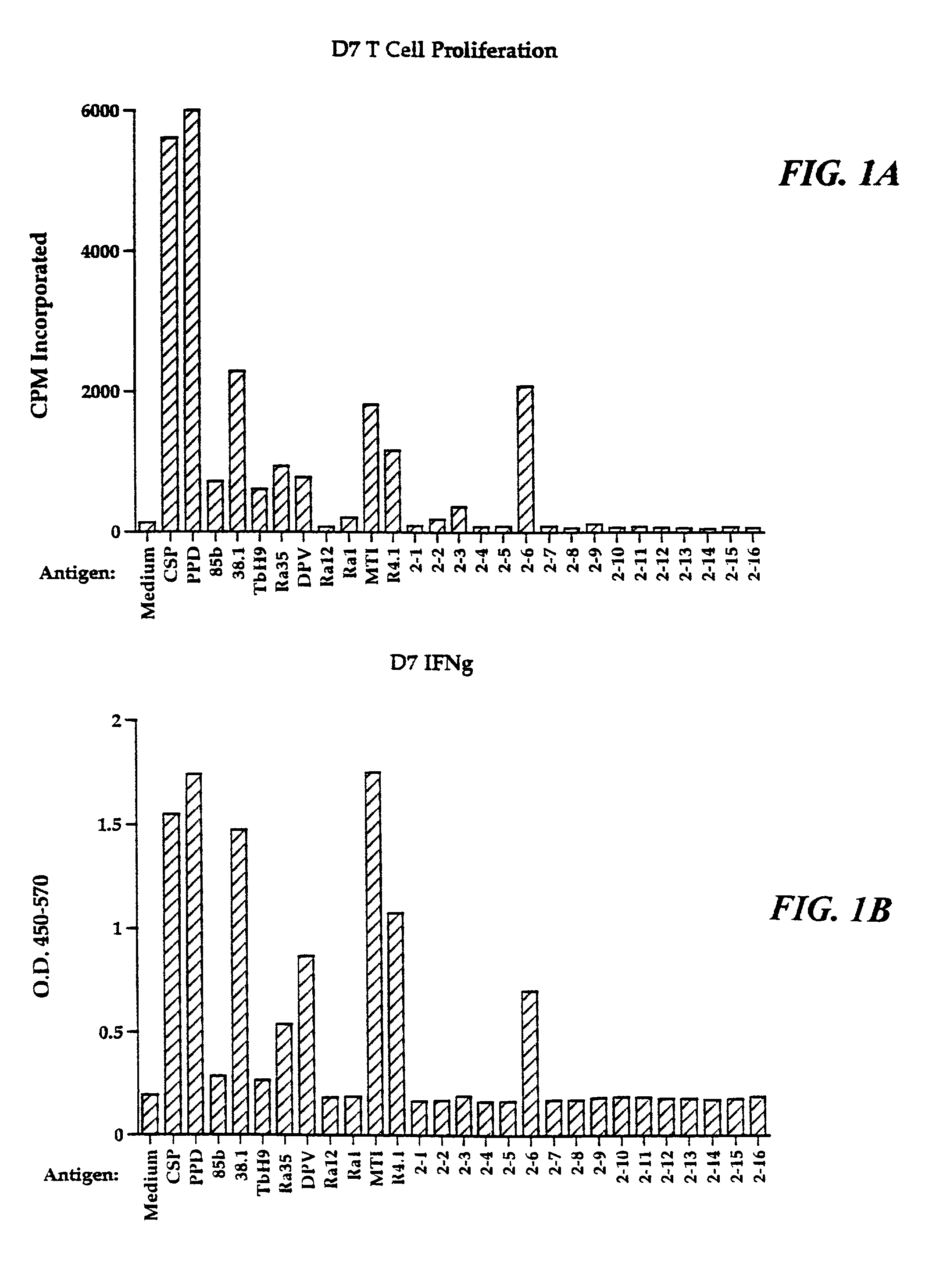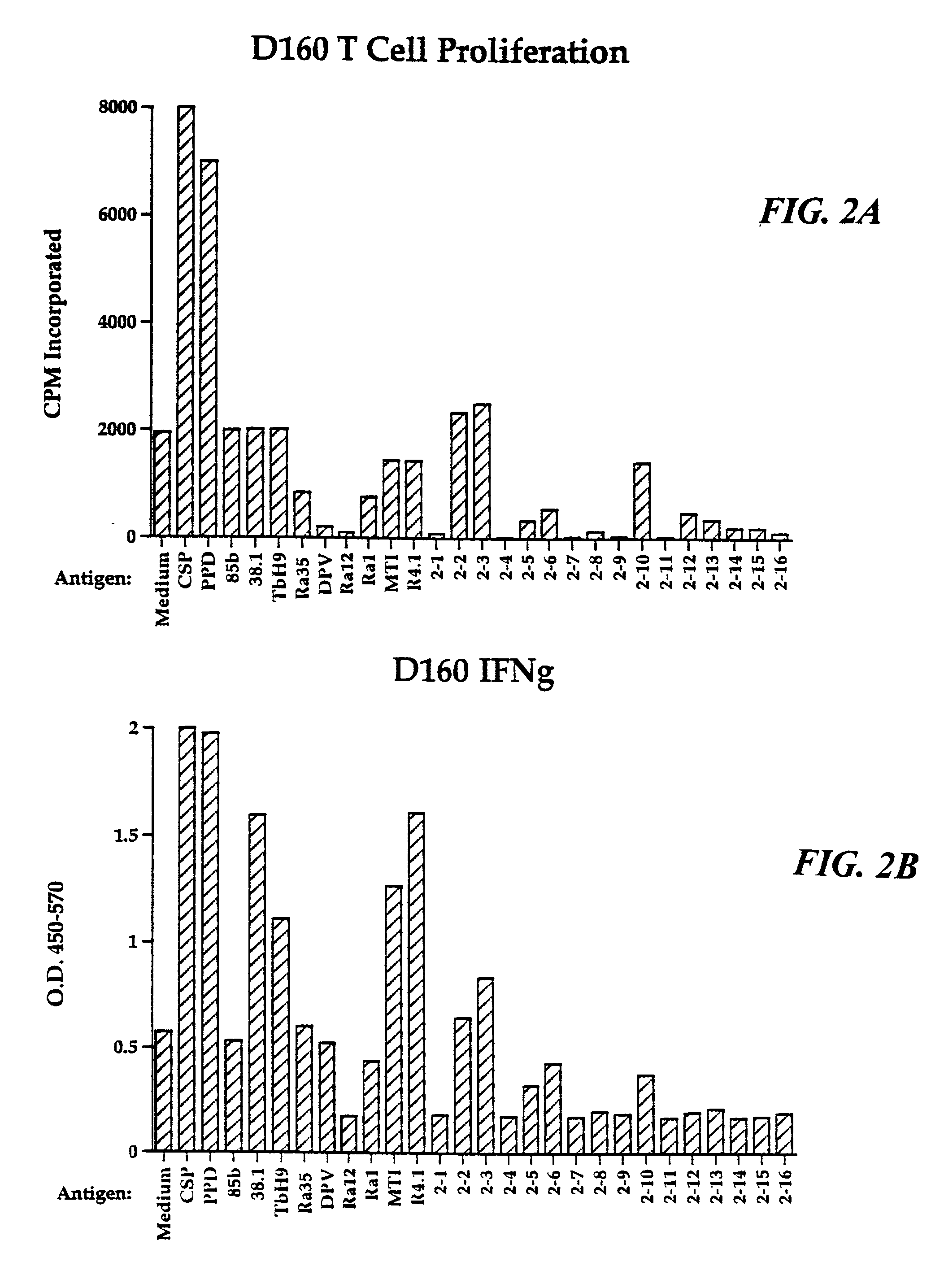Compounds for diagnosis of tuberculosis and methods of their use
a tuberculosis and compound technology, applied in the field of polypeptides, can solve the problems of difficult monitoring of patient behavior, insufficient treatment to prevent the spread of the disease, and serious complications and death
- Summary
- Abstract
- Description
- Claims
- Application Information
AI Technical Summary
Benefits of technology
Problems solved by technology
Method used
Image
Examples
example 1
Purification and Characterization of M. tuberculosis Polypeptides Using CD4+ T Cell Lines Generated from Human PBMC
[0060] M. tuberculosis antigens of the present invention were isolated by expression cloning of cDNA libraries of M. tuberculosis strains H37Rv and Erdman essentially as described by Sanderson et al. (J. Exp. Med., 1995, 182:1751-1757) and were shown to induce PBMC proliferation and IFN-.gamma. in an immunoreactive T cell line.
[0061] Two CD4+ T cell lines, referred to as DC-4 and DC-5, were generated against dendritic cells infected with M. tuberculosis. Specifically, dendritic cells were prepared from adherent PBMC from a single donor and subsequently infected with tuberculosis. Lymphocytes from the same donor were cultured under limiting dilution conditions with the infected dendritic cells to generate the CD4+ T cell lines DC-4 and DC-5. These cell lines were shown to react with crude soluble proteins from M. tuberculosis but not with Tb38-1. Limiting dilution condit...
example 2
Induction of T Cell Proliferation and Interferon-.gamma. Production by M. tuberculosis Antigens
[0080] The ability of recombinant M. tuberculosis antigens to induce T cell proliferation and interferon-.gamma. production may be determined as follows.
[0081] Proteins may be induced by IPTG and purified by gel elution, as described in Skeiky et al. J. Exp. Med., 1995, 181:1527-1537. The purified polypeptides are then screened for the ability to induce T-cell proliferation in PBMC preparations. The PBMCs from donors known to be PPD skin test positive and whose T-cells are known to proliferate in response to PPD, are cultured in medium comprising RPMI 1640 supplemented with 10% pooled human serum and 50 .mu.g / ml gentamicin. Purified polypeptides are added in duplicate at concentrations of 0.5 to 10 .mu.g / mL. After six days of culture in 96-well round-bottom plates in a volume of 200 .mu.l, 50 .mu.l of medium is removed from each well for determination of IFN-.gamma. levels, as described be...
example 3
Purification and Characterization of M. tuberculosis Polypeptides using CD4+ T Cell Lines Generated from a Mouse M. tuberculosis Model
[0083] Infection of C57BL / 6 mice with M. tuberculosis results in the development of a progressive disease for approximately 2-3 weeks. The disease progression is then halted as a consequence of the emergence of a strong protective T cell-mediated immune response. This infection model was used to generate T cell lines capable of recognizing protective M. tuberculosis antigens.
[0084] Specifically, spleen cells were obtained from C57BL / 6 mice infected with M. tuberculosis for 28 days and used to raise specific anti-M. tuberculosis T cell lines as described above. The resulting CD4+ T cell lines, in conjunction with normal antigen presenting (spleen) cells from C57BL / 6 mice were used to screen the M. tuberculosis Erd .gamma.screen library described above. One of the reactive library pools, which was found to be highly stimulatory of the T cells, was selec...
PUM
| Property | Measurement | Unit |
|---|---|---|
| concentrations | aaaaa | aaaaa |
| volume | aaaaa | aaaaa |
| volume | aaaaa | aaaaa |
Abstract
Description
Claims
Application Information
 Login to View More
Login to View More - R&D
- Intellectual Property
- Life Sciences
- Materials
- Tech Scout
- Unparalleled Data Quality
- Higher Quality Content
- 60% Fewer Hallucinations
Browse by: Latest US Patents, China's latest patents, Technical Efficacy Thesaurus, Application Domain, Technology Topic, Popular Technical Reports.
© 2025 PatSnap. All rights reserved.Legal|Privacy policy|Modern Slavery Act Transparency Statement|Sitemap|About US| Contact US: help@patsnap.com


